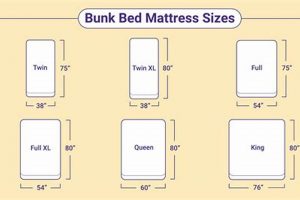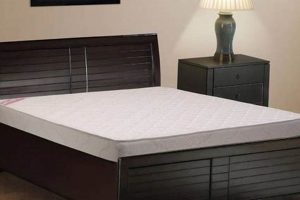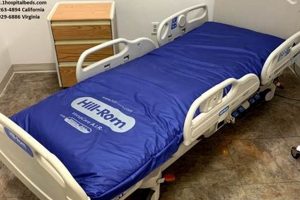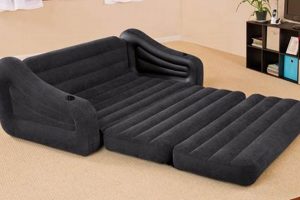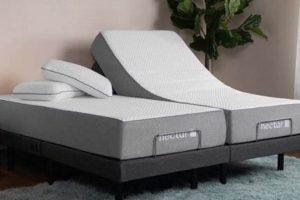The uppermost sleeping surface of a bunk bed structure requires particular attention to dimensions, support, and safety features. These sleeping platforms are designed to fit securely within the bunk frame, providing a comfortable area for rest while adhering to established safety standards for elevated sleeping arrangements.
A proper sleeping surface enhances the overall safety and comfort of the top bunk. Adequate support minimizes the risk of falls and contributes to a restful sleeping experience. Historically, choices for these bunks were limited, but contemporary options encompass a broader range of materials and construction techniques designed to improve sleep quality and structural integrity.
Considerations for selecting an appropriate sleeping surface include thickness, weight, material composition, and fire retardancy. Evaluating these factors ensures a safe and supportive environment for the individual utilizing the top bunk. These key points will be further detailed in the following sections.
Essential Considerations for the Upper Bunk Sleeping Surface
Selecting an appropriate sleeping surface for the top bunk requires careful consideration to ensure safety, comfort, and longevity. Adherence to the following guidelines will aid in making an informed decision.
Tip 1: Prioritize Safety Certifications: Verify that any potential purchase adheres to safety certifications such as those from the Consumer Product Safety Commission (CPSC). These certifications indicate the product has undergone testing to meet specific safety requirements.
Tip 2: Assess Thickness Constraints: Top bunks often have a maximum thickness restriction due to safety rails. Exceeding this limit reduces the effectiveness of the safety rails, increasing the risk of falls. Consult the bunk bed manufacturer’s specifications for the recommended thickness.
Tip 3: Evaluate Weight Capacity: Ensure the chosen sleeping surface’s weight capacity aligns with the intended user’s weight. Exceeding the weight limit can compromise the support structure and potentially lead to structural failure.
Tip 4: Consider Material Composition: Options range from innerspring to memory foam to latex. Each material offers varying levels of support, comfort, and durability. Select a material that aligns with the sleeper’s preferences and any specific orthopedic needs.
Tip 5: Address Fire Retardancy: Compliance with fire safety standards is crucial. Look for sleeping surfaces that meet or exceed established fire retardancy regulations. This feature can significantly impact safety in the event of a fire.
Tip 6: Measure Precisely: Accurate measurement of the bunk frame is paramount. A sleeping surface that is too large will not fit, while one that is too small poses a safety hazard due to potential gaps.
Tip 7: Research Warranty Coverage: A comprehensive warranty offers protection against manufacturing defects and premature wear. Thoroughly review the warranty terms and conditions before finalizing a purchase.
Implementing these guidelines ensures a safer and more comfortable sleeping environment for the occupant of the top bunk, reducing the risk of accidents and promoting restful sleep.
The subsequent sections will delve into specific features and options available for top bunk sleeping surfaces, providing further guidance for selecting the most suitable product.
1. Dimensions and Thickness
The dimensions and thickness of a top bunk sleeping surface are critical parameters directly impacting safety and functionality. The length and width must precisely match the bunk frame’s interior dimensions to prevent slippage or gaps, which pose a fall hazard. Deviation from these dimensions can compromise the integrity of the sleeping platform. For example, a sleeping surface that is too narrow creates gaps where limbs can become trapped, while an oversized one will not fit properly within the frame.
Thickness, or height, is equally important due to the proximity of the safety rails. A sleeping surface exceeding the recommended thickness reduces the effective height of the rails, diminishing their ability to prevent falls. Many bunk bed manufacturers specify a maximum thickness to maintain compliance with safety regulations. Non-compliance can lead to serious injuries, particularly for younger users. A thicker profile also adds to the overall weight, potentially exceeding the bunk frame’s load-bearing capacity.
Therefore, accurate measurement and adherence to manufacturer specifications are essential. Overlooking these aspects can lead to instability, reduced safety rail effectiveness, and potential structural damage. Prioritizing correct dimensions and thickness ensures a secure and safe sleeping environment for the top bunk occupant, mitigating the risk of accidents associated with improperly sized sleeping surfaces.
2. Support and Comfort
The relationship between support and comfort is paramount when selecting a sleeping surface for a top bunk. These attributes directly influence sleep quality, physical well-being, and overall safety, especially given the restricted space and elevated position inherent in bunk bed design.
- Spinal Alignment and Posture
A supportive top bunk sleeping surface maintains proper spinal alignment throughout the night. Inadequate support can lead to poor posture and contribute to back pain or discomfort. Materials such as memory foam or latex, which conform to the body’s contours, promote healthy spinal alignment. Conversely, a surface that is too soft may cause the spine to sag, while one that is too firm may exert excessive pressure on certain areas.
- Pressure Relief and Circulation
Effective pressure relief is crucial for preventing discomfort and promoting healthy circulation. Areas of high pressure, such as hips and shoulders, can restrict blood flow and cause tossing and turning during sleep. Sleeping surfaces that distribute weight evenly across the body minimize pressure points. Innerspring designs with individually encased coils and layered foam constructions are often employed to achieve pressure relief. This is especially critical for the top bunk where movement may be restricted due to safety rails.
- Material Density and Firmness
Material density and firmness influence both support and comfort. Higher density materials tend to offer greater support and durability, resisting compression over time. Firmness is a subjective preference, but it should align with the sleeper’s body weight and sleeping position. Side sleepers often prefer a softer surface to accommodate shoulder and hip contours, while back sleepers may benefit from a firmer surface for spinal support. A balance must be struck to prevent sinking too deeply into the surface, which can restric
t movement and contribute to overheating. - Temperature Regulation and Breathability
Temperature regulation is important for comfortable sleep, particularly in the often smaller and less ventilated space of a top bunk. Materials that promote airflow and dissipate heat help prevent overheating and sweating. Latex and open-cell foam constructions are known for their breathability. Covers made from natural fibers, such as cotton or bamboo, can also enhance airflow and moisture wicking. Proper ventilation prevents the buildup of moisture, inhibiting the growth of mold and bacteria, thus contributing to a healthier sleep environment.
In summary, achieving an optimal balance of support and comfort in a sleeping surface designed for the top bunk requires careful consideration of spinal alignment, pressure relief, material density, firmness, and temperature regulation. These factors collectively contribute to a restful and restorative sleep experience, mitigating potential discomfort and ensuring the occupant’s well-being.
3. Weight Capacity
The specified maximum weight allowance for a top bunk sleeping surface is a critical safety parameter. Exceeding this limit can have cascading effects, starting with compromised structural integrity and potentially culminating in catastrophic failure. The sleeping surface, designed to distribute weight evenly across the bunk frame, loses its effectiveness when overloaded. This concentration of excessive force on specific points weakens the frame, particularly at connection joints. For instance, a surface rated for 200 pounds subjected to 250 pounds creates undue stress, leading to bending, cracking, or complete collapse of the supporting structure.
Furthermore, consideration must be given not only to the sleeper’s weight but also to any additional weight exerted during normal use, such as sitting up, rolling over, or engaging in activities like reading. The cumulative effect of these forces can significantly strain the bunk bed’s overall capacity. Failure to observe these guidelines may void warranties and, more importantly, creates a substantial risk of injury. Real-world examples frequently document instances of bunk bed collapses attributed to exceeding weight limits, resulting in injuries ranging from minor bruises to severe fractures.
In summary, understanding and adhering to the weight capacity of a top bunk sleeping surface is non-negotiable for safety. This adherence mitigates structural damage, minimizes the risk of accidents, and ensures the long-term integrity of the bunk bed system. The specified weight limit is not merely a suggestion but a critical design parameter intended to safeguard occupants from potential harm.
4. Safety Compliance
The intersection of safety compliance and a top bunk sleeping surface represents a critical domain of concern for both manufacturers and consumers. Compliance with established safety standards directly mitigates risks associated with elevated sleeping platforms. For example, regulations concerning flammability testing ensure that the materials used in the sleeping surface will not readily ignite and spread fire, thereby increasing occupant safety in the event of a fire. Failure to adhere to these standards creates a demonstrable increase in the likelihood of injury or even fatality. Examples of non-compliant sleeping surfaces include those lacking proper flame-retardant treatment or those that exceed maximum thickness specifications, thereby reducing the effectiveness of safety rails.
One practical application of safety compliance involves rigorous testing of materials and construction methods. Standards set by organizations such as the Consumer Product Safety Commission (CPSC) mandate specific testing protocols to assess the structural integrity, flammability, and chemical composition of sleeping surfaces intended for top bunks. These tests simulate real-world scenarios, such as impact resistance and prolonged use, to ensure the product can withstand normal wear and tear without posing a safety hazard. Furthermore, labeling requirements mandate clear communication of weight limits and other critical safety information to consumers, empowering informed decision-making. Manufacturers failing to meet these requirements face potential legal repercussions and damage to their reputation.
In summary, safety compliance is not merely a regulatory formality but an essential component of any top bunk sleeping surface. It encompasses a range of measures designed to minimize risk and protect occupants. While challenges remain in ensuring consistent enforcement and consumer awareness, a commitment to safety standards provides a tangible benefit in the form of reduced accidents and enhanced well-being. The ongoing evolution of safety regulations reflects a continuous effort to address emerging risks and improve the overall safety of bunk bed systems.
5. Material Durability
Material durability plays a pivotal role in determining the long-term value and safety of a sleeping surface designed for the upper bunk of a bunk bed. The restrictive environment and the inherent safety considerations of an elevated bed necessitate a sleeping surface capable of withstanding prolonged use and potential misuse. The materials employed directly influence the surface’s resistance to compression, tearing, and degradation from exposure to environmental factors like humidity and temperature fluctuations. For instance, a lower-density foam core will compress more rapidly under repeated use, leading to a loss of support and comfort over time, necessitating premature replacement.
The choice of materials also influences the ability of the sleeping surface to maintain its structural integrity under varied stress conditions. A sleeping surface constructed with reinforced seams and high-tensile strength fabric resists tearing and fraying, extending its lifespan and minimizing the risk of compromising its fire-retardant properties. In contrast, a surface employing inexpensive, low-quality materials is prone to rapid wear and tear, creating potential safety hazards, such as exposed foam or compromised structural support. The composition of the sleeping surface’s internal components, such as innerspring coils or foam layers, further contributes to its overall durability. Coils made of tempered steel provide superior support and resistance to deformation, while high-density foam maintains its shape and resilience for a longer period.
Ultimately, material durability is not merely a matter of longevity but a fundamental component of the safety and functionality of the sleeping surface. Selecting a surface constructed with high-quality, durable materials represents a practical investment in long-term value and occupant safety, mitigating the risks associated with premature degradation and ensuring consistent performance throughout the product’s lifespan. Challenges remain in accurately assessing material durability prior to purchase, highlighting the importance of relying on reputable manufacturers and independent testing certifications to ensure the specified materials meet established performance standards.
Frequently Asked Questions
The following addresses commonly encountered questions regarding the selecti
on and maintenance of a sleeping surface intended for the uppermost bunk of a bunk bed structure.
Question 1: What are the typical dimensions of a top bunk sleeping surface?
Standard dimensions generally mirror those of a twin-size sleeping surface (approximately 39 inches wide by 75 inches long). However, specific measurements may vary depending on the bunk bed frame’s design. Precise measurement of the frame’s interior is critical prior to purchase to ensure a proper fit.
Question 2: What is the maximum permissible thickness for a sleeping surface on the top bunk?
The maximum thickness is dictated by the height of the safety rails. Exceeding the manufacturer’s specified thickness compromises the rails’ effectiveness in preventing falls. As a general guideline, a thickness of 6 to 8 inches is often recommended, but the bunk bed’s documentation should be consulted for definitive specifications.
Question 3: What type of sleeping surface material is best suited for a top bunk?
Material selection depends on individual preferences and needs, but options like memory foam, latex, and innerspring are commonly considered. Memory foam conforms to the body, providing pressure relief, while latex offers a balance of support and responsiveness. Innerspring surfaces provide a traditional feel. Factors such as spinal support, temperature regulation, and allergen resistance should be considered.
Question 4: How does the weight capacity of the sleeping surface impact safety?
Adhering to the weight capacity is paramount for safety. Exceeding the stated limit can compromise the structural integrity of both the sleeping surface and the bunk bed frame, increasing the risk of collapse. The weight of the occupant plus any additional weight from bedding or activities must be factored in.
Question 5: What safety certifications should be sought when purchasing a top bunk sleeping surface?
Certifications from organizations such as the Consumer Product Safety Commission (CPSC) indicate that the product has undergone testing to meet specific safety standards. These certifications address factors such as flammability, structural integrity, and chemical emissions.
Question 6: How should a top bunk sleeping surface be properly maintained to ensure longevity and safety?
Regular cleaning, including vacuuming and spot cleaning, helps prevent the buildup of dust mites and allergens. Rotating or flipping the surface, if possible, promotes even wear. Protecting the surface with a waterproof cover safeguards against spills and stains. Adhering to the manufacturer’s care instructions is essential for maintaining the product’s integrity and extending its lifespan.
In summary, informed decision-making regarding a top bunk sleeping surface necessitates careful consideration of dimensions, thickness, material composition, weight capacity, safety certifications, and maintenance practices. Prioritizing these aspects ensures a safe and comfortable sleeping environment.
The subsequent section will provide guidance on selecting a top bunk sleeping surface tailored to specific age groups and individual needs.
Top Bunk Bed Mattress
The preceding exploration of the uppermost bunk’s sleeping surface underscores its importance in ensuring both safety and restorative sleep. Critical facets, including dimensional accuracy, support structure, material composition, and adherence to established safety standards, demand careful consideration. Overlooking these elements introduces potential hazards and diminishes the long-term utility of the bunk bed system.
The selection of an appropriate sleeping surface for the top bunk represents a responsible investment in well-being and structural integrity. Continuous vigilance regarding product safety and adherence to manufacturer guidelines remain paramount. Further research and critical evaluation of available options will contribute to informed purchasing decisions and the creation of a safer, more comfortable sleeping environment for all users.


